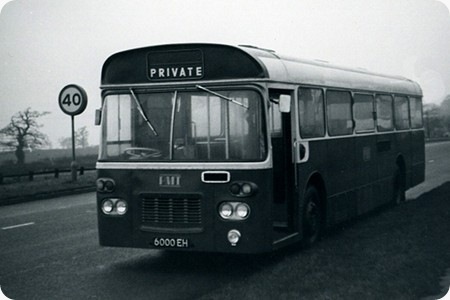PMT – Daimler Roadliner – 6000 EH – SN1000
Potteries Motor Traction
1964
Daimler Roadliner SRC6
Marshall B50F
This is one of the prototype Daimler Roadliners which originally had the Clayton COMPAS heating and ventilation system fitted. There were two radiators, one each side of the bus just in front of the rear wheels which had the twin function of engine cooling and saloon heating. Sounds good in concept but like a lot of things at that time didn’t work reliably in practice. In January 1969 it reappeared with a front mounted radiator and conventional heating, the only PMT Roadliner so fitted. The radiator is hidden behind the front grille, which may look familiar to some as it was the grill fitted to the contemporary Ford Transit van. I cannot remember now why PMT fitted a front radiator to SN1000 and not a rear mounted one in the engine bay like the rest of the fleet. Incidentally the last 6 of the Marshall bodied Roadliners fleet numbers S1086-S1091 also had the COMPAS system – and they were no more reliable than SN1000!!
This was the only PMT Roadliner with air suspension, all the others had Metalastik toggle link suspension. The photo was taken on a test run near Clayton Schools on 20th January 1969.
Photograph and Copy contributed by Ian Wild
I have driven these buses and they were a total disaster, PMT only kept them for about 7 years.
Michael Crofts
I remember the PMT Roadliners. Some of them had home made looking slits in the panels behind the back wheels to improve engine cooling. They were very noisy.
JT
Yes very noisy but sounding totally unlike a bus. It was a sort of deep "Ewwww" muffled roar. When North Western Fleetline 189 was fitted with the same Cummins V6 you could hear it descending Rassbottom St in Stalybridge (On the joint route 90 to Marple) long before it turned into the bus station.
I now regret that I never did take a ride on a Roadliner when I had the chance. A Potteries mate says they were just as deafening from the inside, and that the later Perkins engined ones whilst marginally more reliable, used to waggle their tails dramatically when driven at high revs.
Darlington and Chesterfield Corporations got long service lives out of theirs, whether that suggests they overcame many of the problems, or that the local councillors refused to give up on them for the costs and red faces involved in replacing them early?
Keith Jackson
When I was a boy the PMT Roadliners operated on route 13 to Bentilee. Apart from the noise the bodywork rattled fit to disintegrate! There was an emergency exit window half way along the off side the locking mechanism for which used to jiggle about when the bus was stationary. A big disappointment after the AEC Reliance 590s.
John Tinsley
Our problem at PMT was that we just had too many of the things!! The largest fleet of Roadliners anywhere in the world. The Plaxton bodied ones (timber framed bodies)could possibly have gone on to nearer normal service lives if re engined with Perkins V8s – but at what cost? The Marshall bodied ones (steel framed bodies)were disastrous and although we rebuilt a few at enormous cost in man hours they weren’t a right lot better. By 1972 failures of the Metalastik toggle link suspension units were becoming prevalent. These were expensive to buy and a nightmare to replace. Panhard rod bushes were a recurrent failure – again taking much longer to replace than a leaf spring on a conventional vehicle. We used saloon seats from withdrawn Marshall vehicles to replace the worn out high backed seats in some of Reliances SN801-810 making them more suitable for urban work and less susceptible to vandalism. Happy days!!
Ian Wild
Just a bit of clarification about the ‘home made looking slits’ (ref JT). They were fibreglass corner panels made in house in the fibreglass shop at Stoke and as JT says, the idea was to provide additional engine bay cooling. To the best of my recollection, they were fitted to the 47 Cummins engined Plaxton and Marshall bodied buses. I don’t think they were fitted to the later batch of 10 Plaxtons with Perkins V8 engines.
Ian Wild
08/02/17 – 16:55
I worked with Cummins at that time and spent a year or so carrying out a series of engine changes and modifications for Belfast Corporation. As it was the time of the troubles, suspect much of my efforts ended up as bonfires.
V6 engine wet liners incredibly sensitive to both corrosion and erosion/electrolysis if water filters maintenance neglected. Becoming porous within months.
Mike Hyde
Quick links to the - Comments Page - Contact Page - Home Page
Comments - Please note: The comments facility is not currently available. Please see the home page for updates.
Please Note if you want to send a photograph with your comment please use the Contact Page by clicking here or send as an attachment via email.

